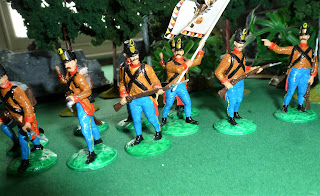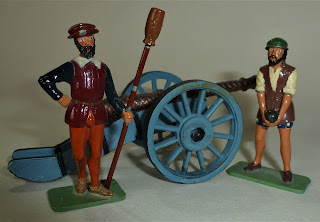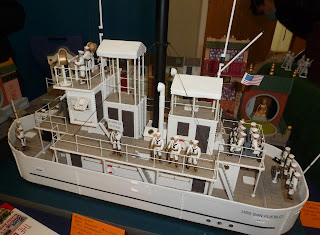I've always liked figures of Hussars and Lancers, light cavalry in general I suppose, and here are three examples of composition personality figures portraying Field Marshal von Makensen from the 1930's.
When I have a little money, I buy Toy Soldiers; and if I have any left, I buy food and clothes. (with apologies to:) ERASMUS
Friday 21 January 2022
August von Mackensen by Elastolin and Lineol
Tuesday 18 January 2022
Figuren Magazine
A few days ago the latest issue of Figuren Magazine landed on the mat:
Articles include: The Freidberg figure show in October 2021. 75 Years of Faller model buildings. From Farm encampment to Wagon fort - late medieval diorama project in 4cm. The unique defence technology of Castle Gaillard - more medieval diorama building 1:25 scale. Boudicca the Heroine by Cherilea. Krupp-Protze trucks as toys. 14cm American GI by Lineol from 1930. Karl May Film Figures. Chingachgook Western figures made in Ukraine by ElastoWit. Mongolian Yak rider by Miniforma. Tipple Topple Zoo. Composition apes by Nardi of Italy. William Tell by REAMSA and others. Childhood Dreams - an Exhibition of knights and castles in Nuremberg
Saturday 15 January 2022
Clay Soldiers - model soldiers and wargaming from the Ukraine
I saved this link some time ago, so must have thought it was worth sharing, but I can't remember what it's about so I decided to just post it anyway!
Friday 14 January 2022
Battle of Metauro revisited
In the closing weeks of last year Anthony and I decided to take his 54mm Battle of Metauro game for another spin, originally this was a board game made in Spain by Rojas y Malaret, Anthony took the original board and had it blown up as a gaming mat for 54mm toy soldiers, here's how the game works: (click on the images to enlarge them)
Tuesday 11 January 2022
Honved infantry for the Risorgimento
Or at least my take on them. I've been sitting on a pile of Airfix Napoleonic French Line infantry and Grenadiers which I've been steadily trying to find other uses for, I got bored with painting French uniforms a long time ago!
Friday 7 January 2022
Unknown Hussar
This is a conversion of an old Britains hollowcast toy Hussar into.... well another Hussar, but who or which Regiment does he represent?
Thursday 6 January 2022
HM of GB Tudor range
The only painted metal I managed to pick up at the London Show last month were these two examples of artillerymen from the short lived HM of BG Tudor World range, the chipped paint might need a bit of a touch up!
Monday 3 January 2022
1920's Lineol Knight
Sunday 2 January 2022
USS San Pueblo at the London Toy Soldier Show
Back in December I went along to the London Toy Soldier Show, I have to admit I was checking each day that it wouldn't be cancelled at the last minute, but they stuck to their guns and with due social distancing it went ahead.
One of the highlights for me was this rather nice model of the USS San Pueblo, I didn't catch the name of the maker but no doubt it will come to light at some point, in the meantime I thought I'd share it anyway. (sure enough, within an hour Antony Spencer has advised me that it's made by The British Toy Soldier Company)
I thought the mood in the show was rather sombre, but that's only to be expected in the circumstances. Still, it didn't stop me adding to the pile of unpainted figures and it was great to get together again with like minded friends for the usual after show drink.
Saturday 1 January 2022
Gustav 1 Vasa by Holger Eriksson
From the Tennfigurer range of model soldiers produced by the master sculptor Holger Eriksson, I don't know who painted him but I think they did a great job on this fine figure.
HAPPY NEW YEAR EVERYONE.
























